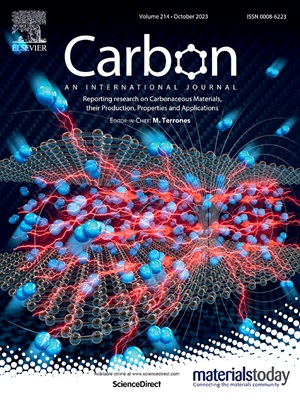氧化Ti3C2Tx纳米片:对防腐和耐磨性有益还是有害?
IF 10.5
2区 材料科学
Q1 CHEMISTRY, PHYSICAL
引用次数: 0
摘要
Ti3C2Tx纳米片由于具有较大的比表面积和较高的力学性能,在防腐耐磨领域显示出巨大的应用潜力。但是,Ti3C2Tx纳米片的应用面临的一个关键挑战是其在水环境中的氧化敏感性。结构的变化必然会对物理和化学性质产生重大的影响,无论是积极的还是消极的影响,而且意见不一,甚至相互矛盾。本研究旨在阐明Ti3C2Tx纳米片氧化程度对其耐蚀耐磨性能的影响。通过调节氧化时间,得到轻度氧化(M-O15min)、中度氧化(M-O12h)和重度氧化(M-O48h)的氧化纳米片。此外,用聚多巴胺(PDA)修饰Ti3C2Tx和氧化纳米片,增强其与水性环氧树脂(EP)的相容性。在100 MPa下AHP浸泡7次后,M@P/EP和M-O48h@P/EP涂层的|Z|0.01Hz分别为2.49 × 108 Ω·cm2和7.06 × 107 Ω·cm2,分别比M-O15min@P/EP涂层(5.27 × 103 Ω·cm2)高5和4个数量级。同时,M@P/EP和M-O48h@P/EP涂层的磨损率分别为1.51 × 10−3 mm3 N−1 m−1和1.10 × 10−3 mm3 N−1 m−1,低于M-O15min@P/EP涂层的磨损率(1.96 × 10−3 mm3 N−1 m−1)。有趣的是,随着Ti3C2Tx纳米片氧化程度的增加,Ti3C2Tx增强涂层的耐蚀性和耐磨性先降低后提高。本研究系统地揭示了Ti3C2Tx纳米片的结构变化如何影响其防腐蚀和耐磨性,为其实际应用提供了有价值的指导。本文章由计算机程序翻译,如有差异,请以英文原文为准。

Oxidation of Ti3C2Tx nanosheets: Beneficial or harmful to corrosion prevention and wear resistance?
Ti3C2Tx nanosheets have showed great potential application in corrosion prevention and wear resistance fields due to their large specific surface area and high mechanical properties. But, a critical challenge for the application of Ti3C2Tx nanosheets is the susceptibility to oxidation in aqueous condition. Structural changes are bound to have a significant impact on physical and chemical properties, whether it is a positive or negative effect, and opinions vary, even contradictory. This study aims to clarify the influence of the oxidation degree of Ti3C2Tx nanosheets on their corrosion and wear resistant behaviors. By regulating the oxidation time, three kinds of oxidized nanosheets were obtained, including slight (M-O15min), moderate (M-O12h) and severe (M-O48h) oxidation. Furthermore, Ti3C2Tx and the oxidized nanosheets were modified with polydopamine (PDA) to enhance their compatibility with waterborne epoxy (EP). After seven cycles of AHP immersion under 100 MPa, |Z|0.01Hz of M@P/EP and M-O48h@P/EP coatings was 2.49 × 108 Ω‧cm2 and 7.06 × 107 Ω‧cm2, which were five and four orders of magnitude higher than that of M-O15min@P/EP coating (5.27 × 103 Ω‧cm2), respectively. Meanwhile, M@P/EP and M-O48h@P/EP coatings exhibited lower wear rates of 1.51 × 10−3 mm3 N−1 m−1 and 1.10 × 10−3 mm3 N−1 m−1 compared to M-O15min@P/EP coating (1.96 × 10−3 mm3 N−1 m−1), respectively. Interestingly, with increasing oxidation degree of Ti3C2Tx nanosheets, the corrosion prevention and wear resistance of Ti3C2Tx reinforced coatings firstly decreased then increased. This work systematically reveals how structural changes in Ti3C2Tx nanosheets affect corrosion prevention and wear resistance, providing valuable guidance for their actual application.
求助全文
通过发布文献求助,成功后即可免费获取论文全文。
去求助
来源期刊

Carbon
工程技术-材料科学:综合
CiteScore
20.80
自引率
7.30%
发文量
0
审稿时长
23 days
期刊介绍:
The journal Carbon is an international multidisciplinary forum for communicating scientific advances in the field of carbon materials. It reports new findings related to the formation, structure, properties, behaviors, and technological applications of carbons. Carbons are a broad class of ordered or disordered solid phases composed primarily of elemental carbon, including but not limited to carbon black, carbon fibers and filaments, carbon nanotubes, diamond and diamond-like carbon, fullerenes, glassy carbon, graphite, graphene, graphene-oxide, porous carbons, pyrolytic carbon, and other sp2 and non-sp2 hybridized carbon systems. Carbon is the companion title to the open access journal Carbon Trends. Relevant application areas for carbon materials include biology and medicine, catalysis, electronic, optoelectronic, spintronic, high-frequency, and photonic devices, energy storage and conversion systems, environmental applications and water treatment, smart materials and systems, and structural and thermal applications.
 求助内容:
求助内容: 应助结果提醒方式:
应助结果提醒方式:


